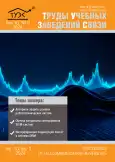Алгоритм защиты роевых робототехнических систем от атак вредоносных роботов с координированной стратегией поведения
- Авторы: Зикратов И.А.1, Зикратова Т.В.2, Новиков Е.А.1
-
Учреждения:
- Санкт-Петербургский государственный университет телекоммуникаций им. проф. М. А. Бонч-Бруевича
- Военно-морской политехнический институт ВУНЦ ВМФ «Военно-морская академия имени Адмирала Флота Советского Союза Н.Г. Кузнецова»
- Выпуск: Том 10, № 3 (2024)
- Страницы: 75-86
- Раздел: ИНФОРМАЦИОННЫЕ ТЕХНОЛОГИИ И ТЕЛЕКОММУНИКАЦИИ
- URL: https://journals.rcsi.science/1813-324X/article/view/259514
- EDN: https://elibrary.ru/XUDVOR
- ID: 259514
Цитировать
Полный текст
Аннотация
Об авторах
И. А. Зикратов
Санкт-Петербургский государственный университет телекоммуникаций им. проф. М. А. Бонч-Бруевича
Email: zikratov.ia@sut.ru
ORCID iD: 0000-0001-9054-800X
SPIN-код: 8991-5212
Т. В. Зикратова
Военно-морской политехнический институт ВУНЦ ВМФ «Военно-морская академия имени Адмирала Флота Советского Союза Н.Г. Кузнецова»
Email: ztv64@mail.ru
ORCID iD: 0000-0001-8365-658X
Е. А. Новиков
Санкт-Петербургский государственный университет телекоммуникаций им. проф. М. А. Бонч-Бруевича
Email: novikov.ea@sut.ru
ORCID iD: 0000-0003-3448-3015
SPIN-код: 5668-1485
Список литературы
- Sailor M.J., Link J.R. Smart dust: nanostructured devices in a grain of sand // Chemical Communications. 2005. Iss. 11. P. 1375.
- Higgins F., Tomlinson A., Martin K.M. Threats to the Swarm: Security Considerations for Swarm Robotics // International Journal on Advances in Security. 2009. Vol. 2. Iss. 2&3. PP. 288–297.
- Page J., Zaslavsky A., Indrawan M. A Buddy model of security for mobile agent communities operating in pervasive scenarios // Proceeding of the Australasian Information Security Workshop (AISW 2004), the Australasian Workshop on Data Mining and Web Intelligence (DMWI 2004), the Australasian Workshop on Software Internationalisation (AWSI 2004), Dunedin, New Zealand, January 2004. Sydney: Australian Computer Society, 2004. Vol. 54. PP. 17–25.
- Schillo M., Funk P., Rovatsos M. Using trust for detecting deceitful agents in artificial societies // Applied Artificial Intelligence. 2000. Vol. 14. Iss. 8. PP. 825–848. doi: 10.1080/08839510050127579
- Golbeck J., Parsia B., Hendler J. Trust Networks on the Semantic Web // Proceeding of the 7th International Workshop on Cooperative Information Agents (CIA 2003, Helsinki, Finland, 27‒29 August 2003). Lecture Notes in Computer Science. Berlin Heidelberg: Springer-Verlag, 2003. Vol. 2782. PP. 238–249.
- Garcia-Morchon O., Kuptsov D., Gurtov A., Wehrle K. Cooperative security in distributed networks // Computer Communications. 2013. Vol. 36. Iss. 12. PP. 1284–1297. doi: 10.1016/j.comcom.2013.04.007
- Strobel V., Castelló Ferrer E., Dorigo M. Blockchain Technology Secures Robot Swarms: A Comparison of Consensus Protocols and Their Resilience to Byzantine Robots // Frontiers in Robotics and AI. 2020. Vol. 7. P. 54. doi: 10.3389/frobt.2020.00054
- Fagiolini A., Pellinacci M., Valenti G., Dini G., Bicchi A. Consensus-based Distributed Intrusion Detection for Multi-Robot Systems // Proceedings of the International Conference on Robotics and Automation (ICRA 2008, Pasadena, USA, 19‒23 May 2008). IEEE, 2008. doi: 10.1109/ROBOT.2008.4543196
- Бешта А.А., Кирпо М.А. Построение модели доверия к объектам автоматизированной информационной системы для предотвращения деструктивных воздействий на систему // Известия Томского политехнического университета. 2013. Т. 322. № 5. С. 104–108. EDN:QOXUKV
- Зикратов И.А., Зикратова Т.В. Использование поведенческих моделей для исследования социумов роботов // Информация и космос. 2022. № 4. С. 170‒174. EDN:DQASLC
- Basan A., Basan E., Makarevich O. Analysis of ways to secure group control for autonomous mobile robots // Proceedings of the 10th International Conference on Security of Information and Networks (Jaipur, India, 13‒15 October 2017). New York: Association for Computing Machinery, 2017. PP. 134‒139. doi: 10.1145/3136825.3136879
- Strobel V., Castelló Ferrer E., Dorigo M. Managing Byzantine Robots via Blockchain Technology in a Swarm Robotics Collective Decision Making Scenario: Robotics track // Proceedings of the International Conference on Autonomous Agents and Multiagent Systems (IntelliSys 2016). Lecture Notes in Networks and Systems. Vol. 16. Cham: Springer, 2018. PP. 541‒549.
- Sargeant I., Tomlinson A. Review of Potential Attacks on Robotic Swarms // Proceedings of the International Conference on Autonomous Agents and Multiagent Systems (IntelliSys 2016). Lecture Notes in Networks and Systems. Vol. 16. Cham: Springer, 2018. PP. 628‒646. doi: 10.1007/978-3-319-56991-8_46
- Рябцев С.С. Метод выявления вредоносных роботов на основе данных процесса коллективного принятия решений в роевых робототехнических системах // Системы управления, связи и безопасности. 2022. № 3. С. 105‒137. doi: 10.24412/2410-9916-2022-3-105-137. EDN:SVSCHG
- Юрьева Р.А., Комаров И.И., Викснин И.И. Иммунологические принципы принятия решения в мультиагентных робототехнических системах // Глобальный научный потенциал. 2015. № 5(50). C. 87‒91. EDN:UKOVSB
- Юрьева Р.А., Комаров И.И., Масленников О.С. Разработка метода обнаружения и идентификации скрытого деструктивного воздействия на мультиагентные робототехнические системы // Программные системы и вычислительные методы. 2016. № 4. C. 375‒382. doi: 10.7256/2305-6061.2016.4.21128. EDN:XIAJDB
- Valentini G., Brambilla D., Hamann H., Dorigo M. Collective Perception of Environmental Features in a Robot Swarm // Proceedings of the International Conference on Swarm Intelligence. Lecture Notes in Computer Science. Vol. 9882. Cham: Springer, 2016. PP. 65‒76. doi: 10.1007/978-3-319-44427-7_6
- Каляев И.А., Гайдук А.Р., Капустян С.Г. Модели и алгоритмы коллективного управления в группах роботов. М.: ФИЗМАТЛИТ, 2009. 280 с. EDN:MUWSIT
- Зикратова Т.В. Метод группового управления в мультиагентных робототехнических системах в условиях воздействия дестабилизирующих факторов // Труды учебных заведений связи. 2021;7(3):92‒100. doi: 10.31854/1813-324X-2021-7-3-92-100. EDN:JFMYBF
- Zikratov I.A., Lebedev I.S., Gurtov A.V., Kuzmich E.V. Securing swarm intellect robots with a police office model // Proceedings of the 8th IEEE International Conference on Application of Information and Communication Technologies (AICT, Astana, Kazakhstan, 15‒17 October 2014). IEEE, 2014. doi: 10.1109/ICAICT.2014.7035906
- Лефевр В.А., Смолян Г.Л. Алгебра конфликта. М., 1968. 51 с.
- Городецкий В.И. Поведенческие модели кибер-физических систем и групповое управление: основные понятия // Известия ЮФУ. Технические науки. 2019. № 1(203). С. 144–162. doi: 10.23683/2311-3103-2019-1-144-162. EDN:LYUZBR
- Карпов В.Э. Социальные сообщества роботов: от реактивных к когнитивным агентам // Мягкие измерения и вычисления. 2019. № 2(15). С. 61‒78. EDN:SEFEFV
Дополнительные файлы






